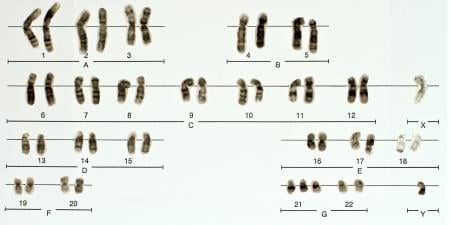Mahadevia PJ, Fleisher LA, Frick KD, Eng J, Goodman SN, Powe NR. Lung cancer screening with helical computed tomography in older adult smokers: a decision and cost-effectiveness analysis. JAMA. 2003;289(3):313-322.
Background
Lung cancer is the leading cause of cancer-related deaths for both men and women in the United States. It accounts for 163 510 deaths a year, which is 29 percent of all annual cancer deaths. An estimated 172 570 cases of lung cancer will be diagnosed in 2005 [1], and three-fourths of those patients will have metastases beyond the lung at the time of their diagnosis. The average 5-year survival rate is 15 percent if metastatic disease is present [2] whereas patients who are diagnosed with stage I lung cancer have a 5-year survival rate of more than 60 percent [3]. Hence, the benefit of early diagnosis and treatment is evident and compelling.
The goal of screening asymptomatic populations is to diagnose a disease at a stage when early diagnosis and treatment makes a clinical difference. Lung cancer, with its prevalence, mortality, and known risk factors, is an excellent candidate for screening. But multiple large scale screening studies using chest radiographs and sputum have shown no reduction in lung cancer mortality [3,4].
Technological advancements in medicine, notably the widespread use of computed tomography (CT), have reopened possibilities and renewed interest for effective screening. Low dose helical CT scanning of the chest can pick up small pulmonary lesions and may be useful diagnostically. Furthermore, extensive advertising to consumers for screening CT scans has increased the demand for these studies [5]. On the one hand, the benefits of screening are obvious: early detection, early treatment, and improved life expectancy. On the other hand, there are risks associated with screening. Cancerous lung lesions can appear as noncalcified nodules on CT, but most noncalcified nodules are benign. So, screening necessarily subjects many people who don't have lung cancer to invasive follow-up tests, significant costs, and increased anxiety.
At present, 2 large randomized controlled studies are in the process of evaluating the efficacy of CT scanning for lung cancer. The National Lung Cancer Screening Trial (NLCST) was started in 2002 by the National Cancer Institute (NCI). Full subject accrual was completed in February 2004 with 50 000 individuals randomly assigned to either CT or chest radiograph; the subjects will be followed through 2009. There is also a European study involving 20 000 former smokers that will finish around 2010. Until these trials are completed and analyzed, clinicians must rely on projections of smaller studies to determine what is best for their patients.
One such projection using a computer model was reported in Journal of the American Medical Association in 2003. Mahadevia and colleagues presented a computer-simulated model that assessed the cost-effectiveness of CT scanning for lung cancer screening in smokers, as well as the mortality rates and potential harm under a variety of assumptions [6].
Methods
To analyze the cost-effectiveness of screening, Mahadevia and colleagues created a hypothetical study population of 100 000 heavy smokers, all 60 years old. The demographics of the population were adjusted to mirror participants in previously published screening trials. To account for smoking cessation among participants, the population was divided into 3 cohorts: current smokers, quitting smokers (those who had stopped by the time of initial screening), and former smokers (those who had not smoked for more than 5 years). Participants in each group were randomly chosen to receive the CT screening or the chest radiograph. The annual screening was modeled for 20 years, with a 40-year follow-up.
The computer model performed cost-effectiveness analyses at each step and for each parameter in the clinical pathway. Each unscreened participant faced the probability of staying alive without clinically apparent lung cancer, developing lung cancer and dying from it, or developing lung cancer but dying from other causes. Screened participants were given the same overall risks of developing lung cancer, with additional pathways developed for those diagnosed with indeterminate nodules. Participants in groups with suspicious lesions and indeterminate nodules underwent a series of tests and interventions. Those ultimately diagnosed with lung cancer were treated with various management strategies (ie, chemotherapy, radiation, surgery).
Widespread screening of asymptomatic populations has inherent biases—eg, overdiagnosis and lead-time bias, (the perception that screened individuals live longer with the disease than unscreened people when, in fact, their lives are not extended but the disease is simply known about longer)—and the authors adjusted the model to account for these and other biases using rates from other published studies. False negative and false positive rates were factored into the model as were rates of patient nonadherence to clinical advice. A histologic bias was even considered, since cancers detected by helical CT tend to be peripheral tumors, which are more likely to be adenocarcinoma. Endobronchial lesions are more often missed by CT (false-negative) and are more likely to be squamous cell carcinoma [7].
Analysis was conducted for a base-case scenario in which the most accurate estimate for each parameter was used. Next, one-way sensitivity analyses were performed under different extremes for each parameter to assess which were most influential for cost-effectiveness. Finally, a multivariate analysis taking into account changes across multiple parameters was performed using favorable and unfavorable conditions.
Several outcomes were measured to determine cost-effectiveness. The absolute and relative differences in lung cancer-specific deaths were calculated. The number of unnecessary (false-positive) screening tests performed was estimated, as well as the harm from these tests. Finally, the effect of screening on quality-adjusted life-years (QALYs) was determined.
Results
In the base-case scenario of the current smoker cohort, there were 4168 lung cancer deaths per 100 000 persons in the unscreened population and 3615 per 100 000 in the screened group. The absolute mortality reduction was 553 deaths per 100 000 persons, or 13 percent. Those in the screened group underwent 1186 invasive tests or surgeries for benign lesions. The calculated cost-effectiveness of screening was $116 300 per QALY gained. For the quitting and former smokers, the cost-effectiveness was $558 600 and $2 322 700, respectively, per additional QALY.
The authors were also able to change the parameters to create a best-case scenario. This model used current smokers only, decreased nonadherence, decreased cost of CT, increased quality-of-life improvement for detection of small lesions, decreased the length-time and overdiagnosis biases, and eliminated consideration of anxiety over unclear diagnosis from the QALY formula. Under these ideal circumstances, the absolute reduction in lung cancer mortality was 900 people per 100 000, a 16 percent relative difference. The number harmed by unnecessary tests increased to 1520 per 100 000, and the cost per QALY gained was $42 500. Quitting smokers and former smokers had adjusted costs of $75 300 and $94 400 per QALY gained, respectively.
Conclusions
Even under the most favorable of circumstances, CT scanning at current cost per scan seems unlikely to be highly cost-effective as a screening test for lung cancer. Widespread screening causes harm in individuals with benign lesions who undergo invasive follow-up testing.
Critique
The gold standard for determining the actual cost-effectiveness of CT scanning for lung cancer screening is a large-scale randomized controlled trial. Such studies are currently under way, and, until those results are available, pilot studies and computer models will be relied upon to predict the utility of CT-based screening. Mahadevia and colleagues have performed a thoughtful, well-designed computer-simulated model analysis to answer this question, accounting for many variables, from adherence rates to costs of CT scans. The authors made many adjustments in the model and analysis to favor screening efficacy. Indeed, one criticism is that their model is too optimistic and that the actual cost is even greater than they project. An additional limitation of the study is that it did not account for other incidental findings. As more people undergo whole-body (rather than chest-only) CT scanning, diagnoses of incidental renal and adrenal masses, aneurysms, and other abnormalities increase. The authors discussed this limitation in the paper but estimated that it would have little impact on the cost-effectiveness of screening for lung cancer. Furthermore, a computer model is only as good as its assumptions. Changes in technology and advancements in diagnostic and therapeutic technique will also impact the calculations.
As the consumer demand for screening CT scans increases, health care providers are placed in the awkward position of weighing the individual versus societal costs and benefits of screening. The ethical responsibility of conscientious physicians is to educate patients and colleagues and avoid unnecessary screening. Until the results of large scale randomized controlled studies are available, the best evidence (including this article) suggests that CT-based screening for lung cancer is too much for too little.
Question for Discussion
The journal article authors report that, in their computer model, there were 553 fewer deaths from lung cancer per 100 000 current smokers who received CT screening than among the 100 000 current smokers who did not receive scanning—a 13 percent reduction. The authors calculated that the cost-effectiveness of the screening was $116 300 per quality-adjusted life year and concluded that CT scanning for lung cancer is not highly cost-effective. Does this information alter the advice you would give a patient who smokes and wants to have a CT scan of his or her lungs to see whether he or she has lung cancer? Does, or should, this information affect government health policy about reimbursement for lung CT screening?
References
-
American Cancer Society. Cancer Facts and Figures 2005. Available online at: https://www.cancer.org/downloads/CAFF2005f4PWSecured.pdf. Accessed December 27, 2005.
- Travis WD, Travis LB, Devessa SS. Lung cancer. Cancer. 1995;75(1 Suppl):191-202.
- Fontana RS. The Mayo Lung Project: a perspective. Cancer. 2000;89(11 Suppl):2352-2355.
-
Humphrey LL, Teutsch S, Johnson M; the US Preventive Services Task Force. Lung cancer screening with sputum cytologic examination, chest radiography, and computed tomography: an update for the US Preventive Services Task Force. Ann Intern Med. 2004;140(9):740-753.
- Lee TH, Brennan TA. Direct-to-consumer marketing of high-technology screening tests. N Engl J Med. 2002;346(7):529-531.
- Mahadevia PJ, Fleisher LA, Frick KD, Eng J, Goodman SN, Powe NR. Lung cancer screening with helical computed tomography in older adult smokers: a decision and cost-effectiveness analysis. JAMA. 2003;289(3):313-322.
- Henschke CI, Naidich DP, Yankelevitz DF, et al. Early lung cancer action project: initial findings on repeat screenings. Cancer. 2001;92(1):153-159.



